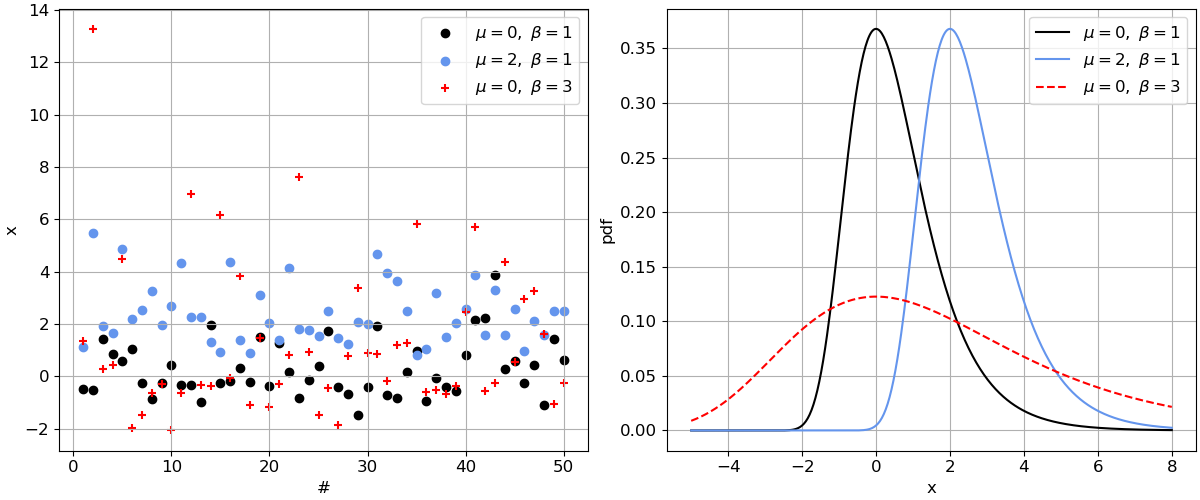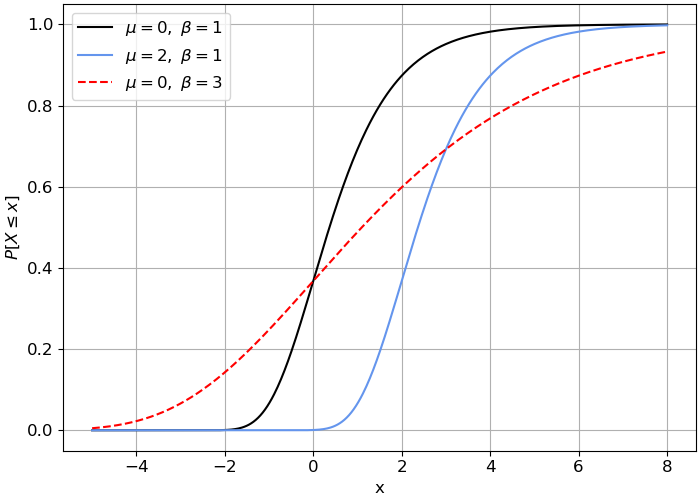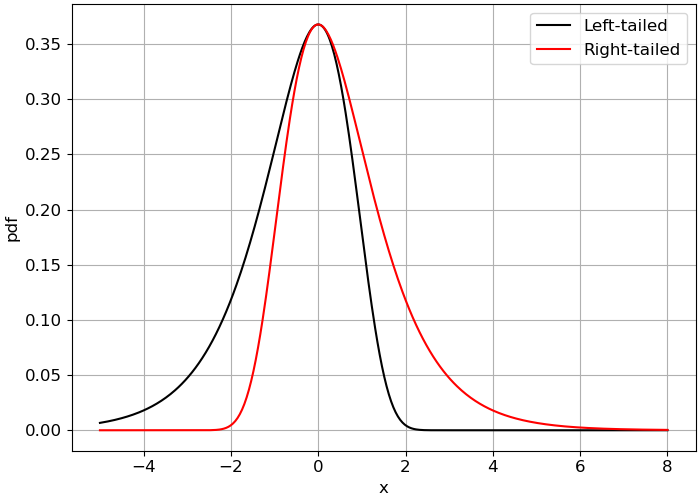# Matplotlib compatibility patch for Pyodide
import matplotlib
if not hasattr(matplotlib.RcParams, "_get"):
matplotlib.RcParams._get = dict.get
Gumbel distribution#
The Gumbel distribution is widely used to model maximum and minimum values of natural phenomena, such as waves, storms, or floods. The PDF of the Gumbel distribution is given by
where \(\mu\) is the location parameter and \(\beta>0\) is the scale parameter. In the figure below the influence of these parameters is presented.
In the right panel of the figure below, an example of the PDF of three Gumbel Exponential distributions is shown. The first two distributions (black and blue continuous lines) present the same \(\beta=1\) but different \(\mu_{black}=0\) and \(\mu_{blue}=2\). This produces a shift towards the positive values of the distribution, being the mode \(=\mu\). Note that the shape of the PDF is identical, so \(\mu\) does not influence the dispersion of the distribution. This can also be seen in the left panel, where random samples from the distribution are drawn. The samples coming from the distribution with \(\mu_{blue}=2\) are higher than those coming from the one with \(\mu_{black}=0\), while both present a similar dispersion.
Regarding the third distribution (red crosses in the left panel and red dashed line in the right panel), it presents the same \(\mu=0\) than the first distribution (black dots in the left panel and continuous black line in the right panel) but different \(\beta\): \(\beta_{black}=1\) and \(\beta_{red}=3\). In the right panel, it can be observed that both distributions present the same mode in \(x=0\). However, the dispersion of the distribution with \(\beta_{red}=3\) is way higher. This effect can also be seen in the random samples in the left panel. Random samples from \(\beta_{black}=1\) range from -2 to 4 approximately, while random samples from \(\beta_{red}=3\) range from -2 to 8 approximately, having one sample a value of almost 14.

Fig. 3.16 Gumbel distribution function: (left) random samples, and (right) PDF.#
Integrating the PDF, the following expression of the CDF is derived
which is displayed in the figure below.

Fig. 3.17 Gumbel distribution function: CDF.#
The influence of the parameters can also be observed in the CDF. The continuous blue and black distributions present the same shape while the blue distribution is shifted towards positive values due to the higher value of \(\mu\). Regarding the dashed red distribution, the slope of the CDF is way more gentle, showing a higher dispersion than the other two distributions due to the higher value of \(\beta\).
Interactive Element#
Below, you find an interactive element that shows the PDF and CDF of a Gumbel distribution. Select whether you want to display the right-tailed or left-tailed version of the Gumbel distribution from the dropdown menu.
Fig. 3.18 Interactively visualize the relationship between the PDF and the CDF of a Gumbel distribution.#
Intuition & Interesting Properties#
The mean of the Gumbel distribution can be computed as
where \(\gamma \approx 0.577\) is the Euler-Mascheroni constant. The variance is given by
Finally, note that Gumbel distribution is not symmetric and presents positive skewness. This is, it presents a tail towards positive values. Actually, the skewness of this distribution can be analytically computed and it is approximately 1.14.
What about a negative tail?#
Although less common, we can also find a variation of the Gumbel distribution with a left tail. The PDF of the left-tailed Gumbel distribution is given by
where \(\mu\) is the location parameter and \(\beta>0\) is the scale parameter. In the figure below the influence of these parameters is presented. Parameter interpretation is equivalent to that for the parameters of the right-tailed one. Integrating the PDF, the following expression of the CDF is derived
Note how the difference in a symbol switches the distribution. If we compare the PDF of a right-tailed and left-tailed Gumbel distributions with the same parameters (\(\mu\)=0 and \(\beta\)=1 in the figure below), the mode of the distribution is identical in both distributions and one PDF is the horizontal mirror image of the other.

Fig. 3.19 Comparison between the left-tailed and right-tailed Gumbel distribution.#
Groundwater quality of a shallow aquifer has been tracked for a year to determine if it is duable to use it or if it is getting polluted. To this end, the daily maximum concentration of chloride in miligrams per liter has been measured. These concentration has been described using a Gumbel distribution with parameters \(\mu=60\) and \(\beta=10\).
Chlorides between 1mg/L an 100mg/L are normal in freshwater. Use the Gumbel distribution to compute the probability of being in that interval.
Attribution
This chapter was written by Patricia Mares Nasarre, Robert Lanzafame, and Max Ramgraber. Find out more here.
